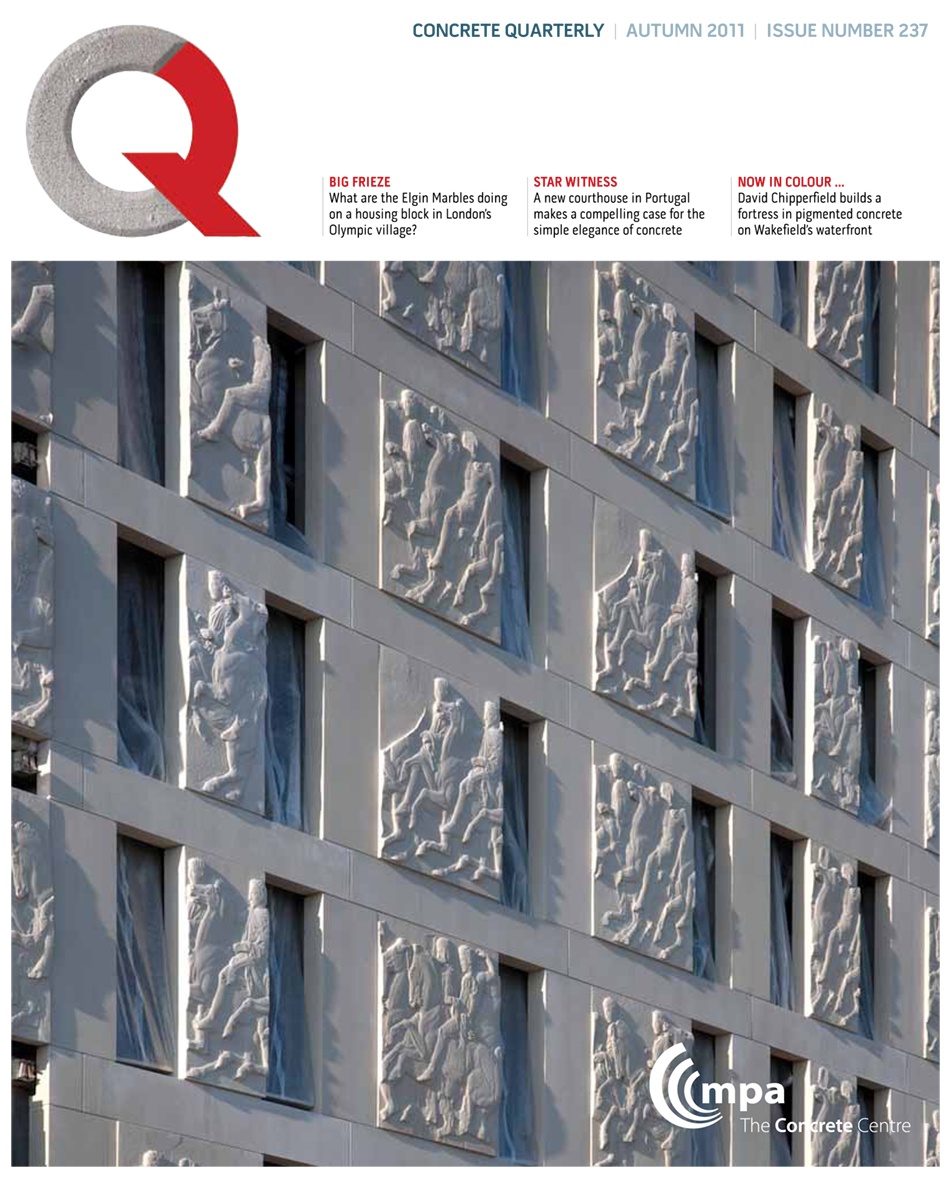Classical Good Looks - Concrete Quarterly
Issue 237
September 2011
Text Graham Bizley
Images Níall McLaughlin Architects
Carved by Greeks, blown up by Venetians, transported to England by Lord Elgin and the subject of heated debate ever since, the sculptures of the Parthenon have had a traumatic history. But for a residential block at the London 2012 Olympics athletes’ village, they have been part of a creative rather than a destructive process. Sections of the frieze have been digitally scanned, made into moulds and cast in concrete to clad the building in a bold attire of light, shadows and movement.
The athletes’ village is a residential development on the east side of the Olympic park that will provide 17,230 beds for competitors and officials during the Games, before conversion into 2,818 flats, half of which will be affordable. Most of these will be in 10-storey courtyard blocks, the first now nearing completion. The scale is unusual – more like something you might find in continental Europe than in London, where tall housing development has generally been limited to widely spaced slab blocks or towers.
So far, 16 architectural practices have been appointed to work on the village, ensuring variety across the 60 buildings. As part of the Olympic Delivery Authority’s commitment to include emerging talent, a number of up-and-coming practices have designed facades for buildings planned by more established names. To some, the idea of designing only the facade of a building overseen by others would be abhorrent. Niall McLaughlin however has seized the opportunity to experiment with precast concrete. “With a cast material you can very accurately lift detail off other things, like in brass rubbing,” he says.
Working on a base building by Glen Howells Architects, McLaughlin has indulged his interest in Gotfried Semper’s theory of dressing (bekleidung), according to which the origins of architecture are thought to lie in the cloaking of a frame with woven hangings as protection against the elements.
The theme of the Parthenon frieze is a procession towards the Acropolis that took place every four years in ancient times as part of the Great Panathenaic Festival. This also included sporting games, so the analogy with the modern Olympics is apt. But McLaughlin plays down this obvious reading and points instead to the iconic status of the Elgin Marbles and the different processes involved in their production. “The Parthenon stones were made in a particular place at a particular time. Their deracination and constant re-idealisation has made them into something else – something iconic that people recognise, like a picture of Elvis.”
On the building the elevations have been composed so that the relief panels appear to be the infill between smooth-cast column and beam elements of a trabeated structure. “We wanted to design facades that would express in a very direct way the frame behind,” McLaughlin says. Despite this apparent clarity, the panels are actually made in various different larger forms with false joints in places. McLaughlin revels in the variety of the precast elements, likening it to the juxtaposition of order and difference in Sol LeWitt’s 122 Variations of Incomplete Open Cubes.
Five different sections of the frieze depicting horses were chosen for the relief panels with the help of British Museum senior curator Ian Jenkins. These sections were scanned digitally while the museum was closed one night by Tom Lomax of the Slade School of Fine Art and Chris Cornish of 3D filming company Inition.
Positive ‘plugs’ were then cut out of a polyurethane model board using a 5-axis router at London Metropolitan University. Using a 5-axis rather than a 3-axis machine allowed the board to be undercut, as a sculptor could do working by hand, which meant the strong shadows of the original are more accurately reproduced. After the initial scanning, the process was managed by specialist precast contractor Techrete.
Negative glass-fibre-backed rubber moulds were made, two from each plug, to allow the concrete casts to be created more quickly. Five different-sized panels were cast from each mould by fixing a temporary stop-end, making a total of 25 panel types. To achieve a white finish, the concrete incorporates white cement with a white Malaga Dolomite aggregate and buff sand from Gloucestershire. The choice of colour is ironic considering the various attempts in the 19th and 20th centuries to ‘restore’ the Elgin Marbles to their assumed original white – the stones would in fact always have had a honey-coloured patina.
The panels are fixed using stainless-steel brackets with tolerance for adjustment in three directions (see drawing). According to Techrete production manager Henry Clifford, the process on site was very carefully planned: “The panels were delivered in a sequence so they could be lifted straight off the trailer on to the building in a single operation.”
A random number generator was used to order the panels on the elevation and there is just enough variety that the repetition is not apparent. The reliefs are always projected in front of the adjacent smooth panels, expressing the primacy of the construction system over the decoration, but they are cut abruptly at the panel edges so the horses seem to jostle in a continuous procession across the facades. By embracing the restrictions of the brief, and the possibilities of precast concrete, McLaughlin has produced a work of dignity and joy.
